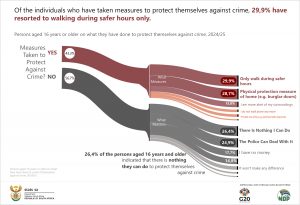Housebreaking remains the most experienced crime affecting South African households in 2024/25, according to the latest Governance, Public Safety and Justice Survey (GPSJS) . Despite this, perceptions of safety have improved slightly. The survey shows that 81,0% of people aged 16 and older felt safe walking alone in their neighbourhoods during the day in 2024/25, compared with 80,4% in 2023/24.
Households most affected by housebreaking
Keep up with the latest headlines on WhatsApp | LinkedIn
The latest report on crime in South Africa shows that housebreaking/burglary has consistently been the most common crime experienced by households in South Africa, followed by home robbery. Male-headed households and those living in KwaZulu-Natal province were most affected.
Over the year (2024/25), an estimated 1,5 million incidents of housebreaking occurred, representing 5,7% of all households in the country.
Housebreaking was one of the least reported household crimes to the police , with only about 43% of affected households taking cases to the police — almost the same proportion as the previous year.
Theft of personal property and consumer fraud dominate personal crimes
When looking at individuals, theft of personal property was the most common crime in 2024/25. A total of 1,2 million people were affected, down from 1,3 million in 2023/24. Thefts were most likely to affect males and people living in metro areas.
An estimated 1,3 million incidents of personal theft took place, affecting about 1,2 million individuals – equal to 2,6% of the population aged 16 and older. However, most victims chose not to report these crimes: 69% chose not to report, while just 31% reported some or all incidents to the police.
Consumer fraud showed a different trend. Incidents rose sharply from 552 000 in 2023/24 to 811 000 in 2024/25. Encouragingly, the share of victims reporting to police also increased from 30,7% to 34,9%.
How individuals try to stay safe
The proportion of adults aged 16 and older who felt safe walking alone in their neighbourhoods during the day declined from 85,0% in 2020/21 to 80,4% in 2023/24, before edging up slightly to 81,0% in 2024/25. By contrast, fewer South Africans reported feeling safe when walking after dark: only 36,1% in 2024/25, up marginally from 34,9% the previous year, but still well below the 39,6% recorded in 2020/21.
Provincial differences were notable. Limpopo recorded the highest proportion of people who felt safe walking alone both during the day (97,2%) and at night (64,2%). Western Cape residents, however, were the most likely to feel unsafe in the daytime (31,4%), while Mpumalanga had the highest share who felt unsafe at night (73,0%).
Those aged 16 years and older are also taking active steps to protect themselves against crime. The share of people who did something to guard against crime rose from 39,9% in 2023/24 to 43,3% in 2024/25. Walking only during safer hours was the most common precaution (29,9%), followed by installing physical protection measures such as burglar doors (28,7%). Nearly 80% (79,9%) of individuals said these measures made them feel safer.
Crime remains one of the defining challenges of life in South Africa, cutting across geography, gender and economic status. Whether in bustling metropolitan centres or small rural towns, households and individuals continue to face the risk of break-ins, robberies, theft and other crimes that disrupt daily life. While police statistics capture reported offences, surveys like the Governance, Public Safety and Justice Survey (GPSJS) provide insight into both reported and unreported crime, giving a fuller picture of the experience safety.
For more information, download the full report here.




